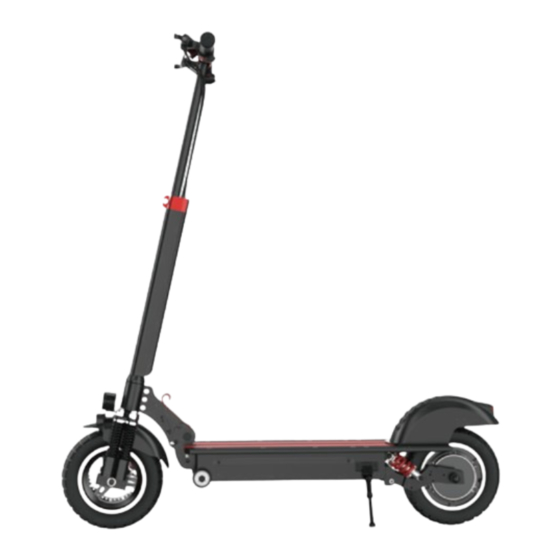
Table of Contents
Advertisement
Advertisement
Table of Contents

Summary of Contents for iScooter iX5
- Page 2 www.iscooterglobal.co.uk support@iscooterglobal.co.uk...
-
Page 3: Table Of Contents
Table of Contents(EN) Scooter display Name of major parts Safety instructions Product introduction Unfolding steps Folding steps Basic operations Display Brake Riding operations Start Riding Stop riding Battery and charger Maintenance Lubrication Tire Brake General troubleshooting Parameters Warranty... -
Page 4: Scooter Display
Scooter display... -
Page 5: Name Of Major Parts
Name of major parts Display Brake lever Handlebar Ront light switch Quick release clamp Front tube Charger port Front light Rear fender Disc brake pad Rear motor Suspension... -
Page 6: Safety Instructions
SAFETY INSTRUCTION 1.This product is suitable for adults and no passengers are allowed. 2.Please wear a helmet and other protective equipment when you are riding. 3.Please ride on the road safely and legally. 4.Practice before riding. 5.Be careful and safe; both hands and feet should be kept on the scooter. 6.Don't turn off the power when you are riding. -
Page 7: Product Introduction
Product introduction Unfolding steps Step 1: Press the folding lever to unfold the scooter. Step 2: Lock the folding lever. - Page 8 Step 3: Expand the handlebar upward and keep it straight. Step 4: Adjust the handlebar to the suitable height and then tighten the quick release clamp.
-
Page 9: Folding Steps
Folding steps Step 1: Pull the sleeves out and fold down the handlebar. Step 2: Release the quick release clamp on the front tube. Press down the handlebar to the bottom. - Page 10 Step 3: Pull out the folding lever and pull the folding clamp to fold down the front tube.
-
Page 11: Basic Operations
Basic operations Display Picture: 1.Power switch 2.Mode switch 3.Trigger throttle 4.Battery level 5.Speedometer 6.Odometer 1. Power switch 1.1In power off status, press the button for 3 seconds to turn on the scooter. It will automatically turn off the power if there is no operation in 5 minutes. -
Page 12: Brake
Brake Please avoid emergency brake which will break the tires and cause slip. Riding operation Start 1.Practice outside and choose good road condition. 2.Open the scooter according to the user manual. 3.Adjust the handlebar to the height that fits you. 4.Open the seat and adjust it to a suitable height. -
Page 13: Battery And Charger
BATTERY AND CHARGER Each scooter has its own battery and charger. Each part has different serial numbers. Please do not charge the scooter with chargers of other brands. Battery Please charge your scooter after you receive this scooter. It is better to fully charge your scooter before first ride. -
Page 14: Maintenance
Maintenance Lubrication Add some lubricant on the folding part of the handlebar every 6 months to keep the handlebar working smoothly. Note: Do not add WD-40 lubes on the scooter. Do not add any lubricant on the front or rear wheel. Tire Both front and rear tires are pneumatic tires, if they are damaged obviously, please contact the distributor to replace them. -
Page 15: Parameters
Parameters Unfolding size 118*60*123cm Folding size 118*20*50cm SPECIFICATION N.W. 27.29kg Maximum load 150kg Maximum speed 25KM/h Climbing ability 15-25° PERFORMANCE Rated voltage Distance 40-45KM Capacity 15AH BATTERY Type Lithium battery Motor type Brushless DC motor Rated power output 9.5 N.m MOTOR Maximum speed 1300rmp... -
Page 16: Warranty
WARRANTY Any of the parts in the following sheet occurs failure in normal use, please contact us, we will provide complete after-sale service. Quality Warranty Parts service description period Failure occurs in Motor 2 year Free of charge normal use Failure occurs in Controller 6 months... - Page 17 Warranty becomes invalid if the followings occur: 1.Haven't maintained according to this manual. 2.Broken parts caused by dangerous actions. 3.Disassembling and assembling by users or use of parts of other brands. Broken parts resulting from traffic accidents or impact from external force by users.













Need help?
Do you have a question about the iX5 and is the answer not in the manual?
Questions and answers